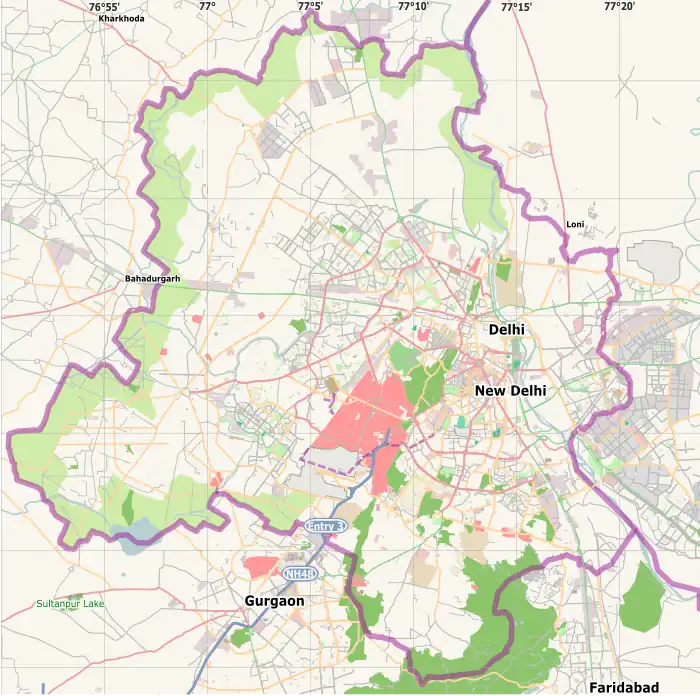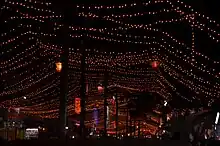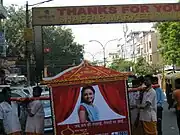Karol Bagh
Karol Bagh (also spelled Qarol Bagh, pronounced [qəroːl baːɣ]) is a neighbourhood in Central District of Delhi, India.[1][2][3] It is a mixed residential and commercial neighborhood known for shopping streets, such as the Ghaffar Market and Ajmal Khan Road.
Karol Bagh
Qarol Bagh | |
|---|---|
Neighbourhood | |
.JPG.webp) Ajmal Khan Road, Karol Bagh (November 2008) | |
 Karol Bagh Location in Delhi, India | |
| Coordinates: 28.6629°N 77.210°E | |
| Country | India |
| State | Delhi |
| District | Central Delhi |
| Population | |
| • Total | 505,242 |
| Time zone | GMT + 0530 |
| PIN Code | 110005 |
| Lok Sabha constituency | New Delhi |
| Vidhan Sabha constituency | Karol Bagh |
| Civic agency | MCD |

It was home to the Karol Bagh Lok Sabha constituency until it was abolished in 2008.
Residential areas W.E.A, Beadon Pura, Reghar Pura, Dev Nagar, and Bapa Nagar have a mix of commercial activities such as wholesale markets Tank Road Garment Market and Hardhyan Singh Road Leather market.
Tank Road wholesale garment market came into existence with a few shopkeepers at the end of the 1980s. It offers multiple stores for ethnic women's wear i.e. suits, sarees, and lehengas.
Etymology
The name Karol Bagh, also spelled Qarol Bagh, derives from the Hindi-Urdu words "Qarol" (क़रोल, قرول) meaning "curved like green chilly" and "Bagh" (बाग़, باغ) meaning "garden".[4][5][3] The place was named for the numerous herbal gardens in the area.[4][5]
History
In the 1920s, the villages of Madhoganj, Jaisingh Pura, Raja ka Bazaar, and others were evacuated to build Connaught Place and nearby areas. The villagers were relocated once to the west of Karol Bagh, then to a second rocky area populated by trees and bushes.[6]
Karol Bagh was primarily populated with Muslims until the mass exodus to Pakistan at the time of the Partition of India in 1947,[7] which also resulted in an influx of refugees from West Punjab and Sindh, many of whom were traders. There is a sizable Marathi-speaking population, a Tamil-speaking population,[8] and a large Bengali community, most of whom are employed in jewellery manufacturing. Karol Bagh hosts one of the oldest Durga Puja in the city.
There were incidents at Karol Bagh during the 1984 anti-Sikh riots, including burning of shops.[9] Karol Bagh was the target of a terrorist bomb blast in Ghaffar Market in October 2008.[10]
Education

The historic Ayurvedic and Unani Tibbia College was inaugurated here by Mahatma Gandhi in 1921,[11] and Sri Guru Nanak Dev Khalsa College of Delhi University is situated here.
Markets
Karol Bagh is popular with affluent people of West and Central Delhi for shopping, with busy markets including Ajmal Khan Road, Arya Samaj Road, the Ghaffar Market (named after freedom fighter Khan Abdul Ghaffar Khan), and Tip Top Market (Established by Sh Sohan Lal Jain in 2000). Western businesses Pizza Hut, TGIF, Reebok, Skechers, Puma and Lacoste have established in Karol Bagh. Eateries include Pind Balluchi. The Karol Bagh market is one of the oldest shopping centers in Delhi. The market offers variety from big air-conditioned showrooms to small and dainty shops in alleys.
Many areas of the market specialise in a particular field:
- Ajmal Khan Road once specialised in inexpensive ready-made garments, cotton yarn, and embroidered garments. Now this road has large stores and international labels, along with Indian munchies and masalas (spices).
- Arya Samaj Road specialises in second-hand books.
- Bank Street is known for its jewellery shops, especially jewellery for the bridal trousseau.
- Ghaffar Market has a diverse array of products, ranging from cosmetics to watches to cell phones to footwear.
Transport
The nearest railway stations are Delhi Sarai Rohilla and Delhi Kishanganj, both about a kilometer from Central Karol Bagh. Karol Bagh is situated at a distance of 20 – 22 km. from the Indira Gandhi International Airport, and 4.1 km. from New Delhi Railway Station.[12] It is also serviced by the Karol Bagh Metro station, located on the Blue Line of the Delhi Metro.
Gallery
 Karol Bagh Market
Karol Bagh Market Karol Bagh Market
Karol Bagh Market Karol Bagh 2019
Karol Bagh 2019 Karol Bagh Metro Station
Karol Bagh Metro Station Karol Bagh Market
Karol Bagh Market Karol Bagh Market
Karol Bagh Market
In popular culture
- A TV series shown on Zee TV, 12/24 Karol Bagh (2009–2010), was shot and produced in Delhi. Its subsequent success started the trend for many TV serials being set in Delhi.[13]
- Zoya Singh Solanki, the central character in the romantic comedy novel by Anuja Chauhan, The Zoya Factor (2008) lives in Karol Bagh, who ends up becoming the lucky mascot for the Indian cricket team in the novel.[14]
- In recent years the 108-foot Hanuman statue has become an iconic landmark marking the entrance to Karol Bagh and is seen regularly featured in Bollywood movies showcasing New Delhi.
- In the 2021 movie Bell Bottom, Akshay Kumar's character lived in Gurudwara Road, Karol Bagh.
- In the movie Befikre, Ranveer Singh's character lived in Karol Bagh. There's a dialogue that says "you might have left Karol Bagh, but Karol Bagh hasn't left you".
References
- Fārūqī, Z̤iāʼulḥasan (1999). Dr. Zakir Hussain, Quest for Truth. APH Publishing. p. 105. ISBN 978-81-7648-056-7.
In August 1925 , the Jamia had been shifted from Aligarh to Delhi and was located in Qarol Bagh, Delhi.
- Report on the Administration of the Delhi Province for 1928-29. Calcutta: Government Of India Central Publication Branch. 1930. p. 106.
- "क़रोल-बाग़". Rekhta. Retrieved 5 January 2022.
qarol-baaG क़रोल-बाग़ قرول باغ a place in Delhi
- Arora, Shilpi (2012). Quintessential Delhi. Friday Gurgaon. p. 15.
Karol Bagh got its name from a number of herbal gardens in the area. It was once spelled as "Qarol Bagh" – "Qarol" means "curved like green chilly".
- "When the spoken word changes meaning". The Financial Express. 25 March 2007. Retrieved 5 January 2022.
It is not Karol baagh but Qarol (meaning curved like a green chilly) baagh.
- "A tale of two cities". Hindustan Times. 1 September 2011. Archived from the original on 2 July 2015.
- Singh, Andrea (1976). Neighbourhood and Social Networks In Urban India. Marwah Publications. p. 67.
- Ganesh, Narayani (15 September 2002). "Ubiquitous 'Madrasi' in Delhi". The Times of India. Archived from the original on 21 October 2012. Retrieved 14 September 2008.
- Das, Veena (2007). Life and words: violence and the descent into the ordinary. University of California Press. p. 137. ISBN 978-0-520-24745-1.
- "Karol Bagh's markets live in constant fear of a terrorist attack". Hindustan Times. 17 October 2015.
- Sah, Ram Swarth (25 December 2003). "Old medicine, new learners". The Hindu. Archived from the original on 12 November 2004. Retrieved 15 December 2007.
- "New Delhi Railway Station Bhavbhuti Marg and Karol Bagh by Road, Distance Between New Delhi Railway Station Bhavbhuti Marg and Karol Bagh , Distance by Road from New Delhi Railway Station Bhavbhuti Marg and Karol Bagh with Travel Time, Karol Bagh Distance from New Delhi Railway Station Bhavbhuti Marg, Driving Direction Calculator from new delhi railway station bhavbhuti marg and karol bagh".
- "Delhi's driving TV content". The Times of India. 17 December 2010. Archived from the original on 4 November 2012.
- "Books: The Zoya Factor: Chick-lit cricket, Interview". CNN-IBN. 21 October 2008. Archived from the original on 11 May 2009.
